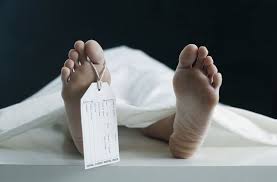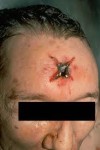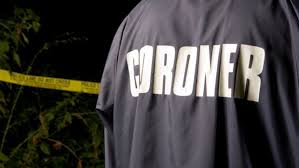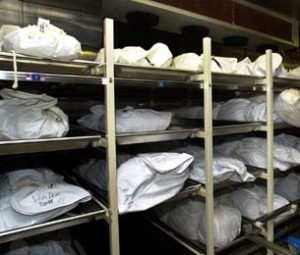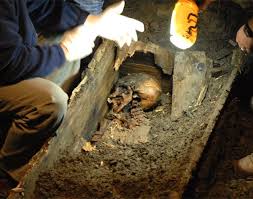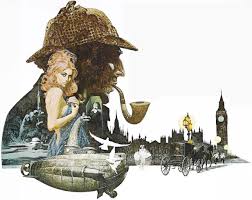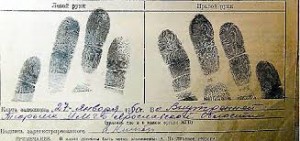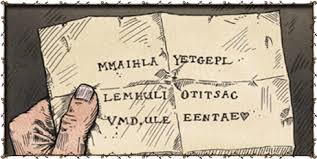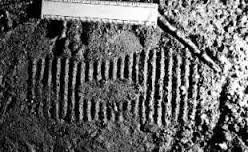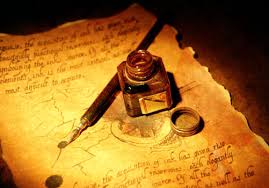 The polygraph, or lie detector, is a forensic investigative tool that’s used as an aid to verify the truthfulness of a person’s statements. Polygraph examinations— properly conducted by trained professionals on competent subjects with a clear issue— are remarkably accurate, but they’re not foolproof. Yes. They’ve been known to be beaten. The question is—can you?
The polygraph, or lie detector, is a forensic investigative tool that’s used as an aid to verify the truthfulness of a person’s statements. Polygraph examinations— properly conducted by trained professionals on competent subjects with a clear issue— are remarkably accurate, but they’re not foolproof. Yes. They’ve been known to be beaten. The question is—can you?
Polygraph examination interpretation is not admissible as evidence in court. They’re not a replacement or shortcut for a proper investigation and a thorough interview of the subject. Statistics show that the majority of people who undergo polygraph examinations are found to be truthful. Perhaps the term Lie Detector should be replaced with Truth Verifier.
 In my policing career, I’ve been involved in well over a hundred polygraph examinations, including getting hooked up myself for a test drive. (Turns out I’m a terrible liar—not sure how I’m gonna make out with this new career as a fiction writer.) The subjects I’d had polygraphed were a mixture of suspects, witnesses, complainants, and victims. I’d say that sixty percent of the subjects were truthful, thirty percent were lying, and ten percent were inconclusive.
In my policing career, I’ve been involved in well over a hundred polygraph examinations, including getting hooked up myself for a test drive. (Turns out I’m a terrible liar—not sure how I’m gonna make out with this new career as a fiction writer.) The subjects I’d had polygraphed were a mixture of suspects, witnesses, complainants, and victims. I’d say that sixty percent of the subjects were truthful, thirty percent were lying, and ten percent were inconclusive.
It makes sense, when you think about it, that the majority are truthful because they know it will work to their advantage. I can’t think of the number of times I’ve had subjects refuse to take the test, giving excuses everywhere from “Those things are rigged to frame me” to “I heard you get testicle cancer from it”.
Before giving you some tips on how to pass a polygraph when you’re dead-ass lying, let’s look at what the thing is and how it works.
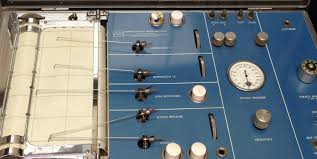 The word polygraph comes from the Greek word polugraphos which means “to sniff-out bullshit”. (Go ahead—call me a liar). Polygraphs have been around since the 1920s and have evolved from clunky paper-reel with ink-pen devices to modern laptops with automated scoring systems. Clinically, the process is known as psychophysiological detection of deception.
The word polygraph comes from the Greek word polugraphos which means “to sniff-out bullshit”. (Go ahead—call me a liar). Polygraphs have been around since the 1920s and have evolved from clunky paper-reel with ink-pen devices to modern laptops with automated scoring systems. Clinically, the process is known as psychophysiological detection of deception.
The instruments are a combination of medical devices that monitor a subject’s physiological responses to a set of questions designed to put the subject under the stress; the stress associated with deception. The involuntary bodily functions include heart rate, blood pressure, respiration, galvanic skin conduction, and perspiration.
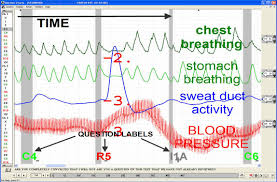 Polygraphic theory dictates that a subject will show a spike in some, or all, of these functions when asked a question and forced to knowingly lie. In a criminal investigation, the examination questions are formed between the polygraphist and the subject during an extensive pre-test interview.
Polygraphic theory dictates that a subject will show a spike in some, or all, of these functions when asked a question and forced to knowingly lie. In a criminal investigation, the examination questions are formed between the polygraphist and the subject during an extensive pre-test interview.
There are four categories of questions—all must be answered “Yes” or “No”. Three categories are control questions and one is issue questions.
Category One is where the subject conclusively knows they’re truthful:
Q — Is your name Garry Rodgers? “Yes”
Q — Are you a retired police officer? “Yes”
Q — Did you make the Amazon Top Ten list? “Yes”
Category Two is asking the subject ambiguous questions:
Q — Is there life after death? “Yes”
Q — Did the chicken come before the egg? “No”
Q — Are you going to make the Top Ten list again? “Dude, let me tell ya…”
Category Three has the subject intentionally lie:
Q — Were you kidnapped by aliens? “Yes”
Q — Did you ever ride a camel? “No”
Q — Are you going to try make the Top Ten list again? “No”
Category Four deals with the issues:
Q — Did you murder Jimmy Hoffa? “No”
Q — Do you know who murdered Jimmy Hoffa? “No”
Q — Did murdering Jimmy Hoffa help you get on the Top Ten list? “It’s not how it looks…”
 Only “Yes” or “No” answers are acceptable during a polygraph examination because the issue has to be clear in the subject’s mind. Black and White. All clarification is worked-out in the pre-test interview. The subject is never surprised by the question, but the question order is completely unknown. This creates an atmosphere of anxiety as the subject waits to hear the questions that really matter.
Only “Yes” or “No” answers are acceptable during a polygraph examination because the issue has to be clear in the subject’s mind. Black and White. All clarification is worked-out in the pre-test interview. The subject is never surprised by the question, but the question order is completely unknown. This creates an atmosphere of anxiety as the subject waits to hear the questions that really matter.
The biggest concern that I’ve heard from people who are asked to submit to a polygraph is “What happens if I’m nervous?”
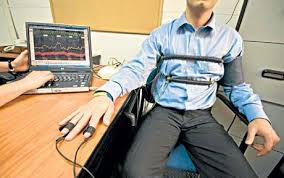 This is expected. Anyone, police officers included, would experience anxiety when being examined. Part of a polygraphist’s skill is to build a rapport with the subject and put them at relative ease before the questioning starts. One of the reasons in building this rapport is to get the subject to volunteer information that the investigation hasn’t uncovered. I’ve seen subjects give critical facts because the right questions weren’t asked during the investigation and I’ve seen subjects fall apart and confess before being strapped into the chair.
This is expected. Anyone, police officers included, would experience anxiety when being examined. Part of a polygraphist’s skill is to build a rapport with the subject and put them at relative ease before the questioning starts. One of the reasons in building this rapport is to get the subject to volunteer information that the investigation hasn’t uncovered. I’ve seen subjects give critical facts because the right questions weren’t asked during the investigation and I’ve seen subjects fall apart and confess before being strapped into the chair.
The key to successful polygraph examinations is the skill of the examiner. The polygraph is just a tool—an extension of the examiner’s mind and voice.
 So — given there’s proven science and skill behind polygraphs — how can you beat one?
So — given there’s proven science and skill behind polygraphs — how can you beat one?
Like I said, given a professional examiner, a competent subject, and a clear issue, polygraph results are remarkably accurate. There’s always exceptions and here’s some tips on how to pass the graph.
-
Prepare well in advance.
-
Research and understand the process so you won’t feel oppressed. The examiner will take every advantage of your ignorance.
-
Know the issue(s) and know what the examiner is looking for.
-
Talk to someone who has experienced a test.
-
Approach the test as an extreme job interview. ‘Dress for the job’. Arrive on time. Sober. Rested. Do not reschedule. Make a good first impression.
-
Know that you’re going to be video recorded.
-
Understand the test starts right when you arrive and ends when you leave. It’s not just the time you’re hooked to the machine.
-
Be on guard. There will be trick questions in the pre-test. It’s part of the process.
-
Listen carefully to what the examiner says and respond accordingly. Do not try and monopolize the conversation.
-
The examiner is not your friend, despite how nice she comes across in the pre-test. Her job is to get to the truth. Remember—you’re dealing with a highly trained professional who knows psychology. If her exam shows you’re deceitful, she’ll go for your jugular in the post-test.
-
Recognize the relevant and irrelevant control questions. Focus on what’s relevant and do not offer more information than what’s pertinent to the issue.
-
Play dumb. Don’t try to impress the examiner that you’ve studied up. You’ll only look stupid.
-
Breathe normally. Shortness of breath naturally triggers the other body functions to accelerate and it will increase nervousness.
-
Take lots of time to answer.
-
Think of something mentally stressful when answering a control question—like the time when you were a kid and your dog was hit by the train. That will raise the ‘normal’ graph peaks.
-
Think of something calming when answering issue questions—like getting a new puppy. That will flatten stress peaks.
-
Keep your eyes open during the questions. The examiner will ask you to close them because this significantly alters your sensory awareness and puts you at a disadvantage. This is very important.
-
Bite your tongue during every question except the truthful control ones. This levels the playing field.
So, who’s got away with taking a lie detector?
 I call her The Mother From Hell. I investigated a bizarre case of Munchausen Syndrome by Proxy—a rare form of child abuse where a parent causes harm to their child to bring attention to themselves. This woman repeatedly complained that her infant daughter was choking, then was caught by hospital staff with her hands on the girl’s neck. She denied it. We polygraphed her. She blew the needles off the machine and confessed. The Mother From Hell got off in court because they ruled her confession inadmissible due to it being elicited under oppression from the polygraph examination.
I call her The Mother From Hell. I investigated a bizarre case of Munchausen Syndrome by Proxy—a rare form of child abuse where a parent causes harm to their child to bring attention to themselves. This woman repeatedly complained that her infant daughter was choking, then was caught by hospital staff with her hands on the girl’s neck. She denied it. We polygraphed her. She blew the needles off the machine and confessed. The Mother From Hell got off in court because they ruled her confession inadmissible due to it being elicited under oppression from the polygraph examination.


